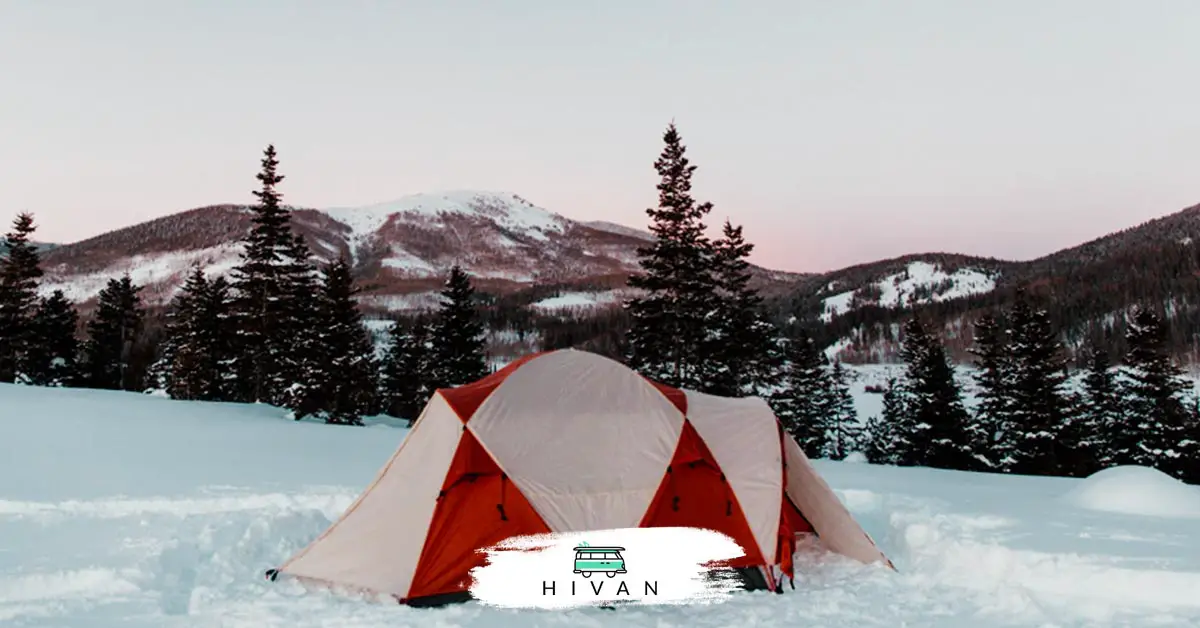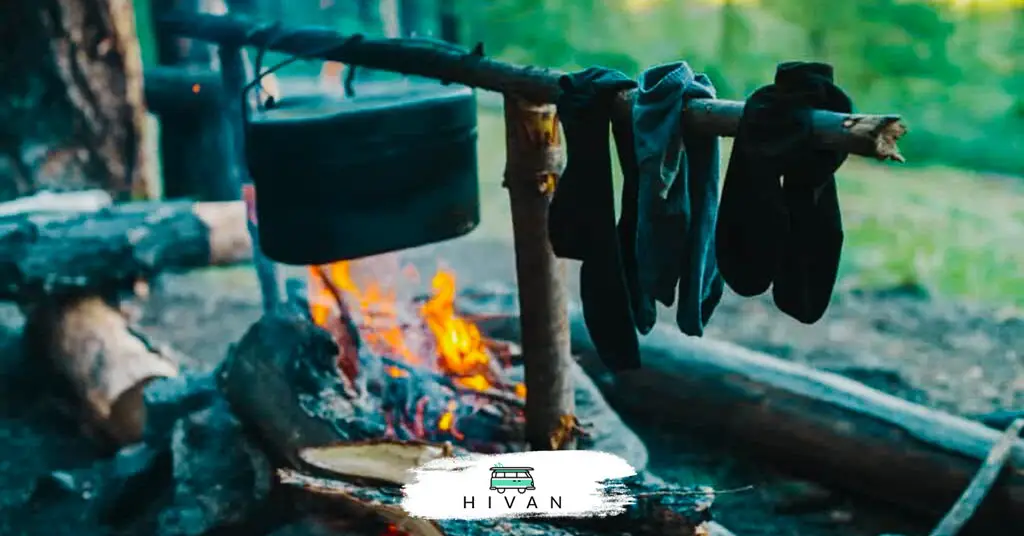Hi-van is supported by its audience. When you purchase using our links, we may earn an affiliate commission (no added cost to you). Learn more
Staying dry while you’re winter camping is essential for not only comfort but also for safety reasons. Walking around in damp clothes is a sure-shot way of getting hypothermia. Keeping your clothes dry while camping does not have to be too complicated.

Here’s a complete guide to drying clothes while winter camping:
- Wear sweat-wicking and quick-dry material.
- Carry a clothesline and fuel.
- Build a campfire or carry a stove.
- Use a dry towel or your sleeping bag.
- Use the active drying method.
Read on for more information on how you can use these methods to dry your clothes while camping outside in the winter.
Related Articles: How To Shower While Winter Camping: Complete Guide How to Dry Your Hair While Camping (7 Methods)
1. Wear Sweat-Wicking and Quick-Dry Material
To ensure that you have the best possible opportunity of drying your clothes while camping, wear material that will wick sweat away and dry quickly. Don’t wear cotton as the material is very bad at wicking moisture away and dries very slowly.
If your cotton clothes get wet, they stay wet and will ensure that you catch a chill.
Manage your clothing carefully to ensure that you’re comfortable but not sweating heavily. The more you sweat, the damper your clothes will get and the more difficult it’ll be to get them to dry out again.
Wear multiple layers so that even if your inner layer gets sweaty and damp, the outer layers will remain dry. If your innermost layers are made of polypropylene or other hydrophobic fabrics, they’ll dry out quickly.
Your outer layers should be wool, pile, or fleece. Pile or fleece tend to hold less water than wool and so will dry faster than wool.
Make sure that you don’t carry too many clothing items, but you want clothing that dries quickly will make drying clothes while winter camping easy.
Another factor to keep in mind is the feet. Make sure your boots are waterproof so that you can keep your socks from getting wet, as socks generally take a long time to dry. It’s just as important to wear multiple layers of socks as it is to layer on the rest of the body.
Keep the innermost layer a sweat-wicking, insulating layer, and you’ll be all set.
2. Carry a Clothesline and Fuel
Clotheslines are useful for hanging up damp and wet clothes. However, drying clothes on a clothesline requires heat, dryness, and wind to get the water to evaporate out of the clothes.
In winter, heat is definitely unavailable, so a good option would be to carry fuel that can warm up the tent you’re staying in. This way, your clothes will also be protected from the damp outside if you’re in a rainy space.
The warmth of the tent will encourage evaporation and help the clothes dry out faster.
If you can’t carry fuel, hang your clothesline outdoors between trees or tents, and leave your clothes out for as long as you can. If you luck out, the days will be dry with mild winds, which will encourage evaporation, and your clothes will dry out.
3. Build a Campfire or Carry a Stove

Another way to use heat on your damp clothes is to build a campfire. Hang your clothes up near the campfire, either by spreading them on the roof of your tent, hanging them up on a clothesline, or on a flat rock near you.
Don’t hang your clothes over the campfire as this is a safety risk, and your clothes will most definitely burn.
- Cooking power: Up to 20,000 total BTUs. Fits a 12-inch and 10-inch pan at the same time.
Stoves such as the Coleman Gas Camping Stove (available on Amazon.com) are likely to be a part of your winter camping gear regardless as you’ll need to cook your food. So even when campfires aren’t possible due to a lack of firewood, you’ll have the stove, which is a source of heat.
Use the stove just as you would use a campfire to dry your clothes.
A stove will emanate less heat than fire, so you might want to bring your clothes a bit closer, but always be aware of the potential fire hazard.
4. Use a Dry Towel or Your Sleeping Bag
Campers frequently rely on dry towels and sleeping bags to dry out their wet clothes when necessary.
- Microfiber
- Quick-drying microfiber towel for camp, beach, sport, and travel
- Super absorbent fabric soaks up four times its weight in water; wrings out easily
Sports towels that dry quickly are a great option for wicking away moisture from damp clothing. Towels such as the PackTowl Quick Dry Towel (available on Amazon.com) are usually made of microfiber, which absorbs a lot of water and dries quickly.
To use your towels, first ensure that the towels themselves are dry and clean. Layout your damp clothes on the towels and roll them up together. The towels will absorb the moisture from your clothes, so you don’t have to wear your wet gear.
If your clothes aren’t too wet or only wet in patches, you can press the towels against the wet patches and absorb the worst of the damp.
Alternatively, you can use your sleeping bag. Most sleeping bags are made of insulating layers and tend to be waterproof, so you’ll have to throw your clothes inside. The thickness of the sleeping bag allows it to absorb moisture without feeling damp.
However, there’s a limit to how much water a sleeping bag can absorb before it saturates and becomes unusable, so only throw in clothes that are damp, not wet. You should also avoid using the sleeping bag unless you’re desperate.
R
5. Use the Active Drying Method
Sleeping in your gear is frequently recommended as your body heat will help dry out your clothes, and the sleeping bag will protect you from catching a chill. When doing this, it’s important to ensure that the layer closest to your skin is dry.
A way to take this method of using body heat to dry clothing further is the active drying method recommended by a sea kayak guide.
To use the active drying method on your clothes, take off all your wet layers as soon as you reach the place where you’re setting up camp. Put on a dry layer close to your skin and put the wet layers back on, and a final insulating layer over all of that. As you move around, setting up camp, your body will heat up, which will then heat and dry out your wet clothing.
You can also keep them on when you’re cooking at your stove or over a campfire to encourage further evaporation.
Conclusion
Winter camping is not an activity for the weak, especially if your clothing gets wet while you’re camping. Depending on the weather, and the location you’re camping, you might be able to dry your clothes outdoors on a clothesline.
But, having a source of heat regardless of whether your clothing is wet or not is a good idea, as it gives you warmth and a cooking source.
Find this content useful 🙂 ?
Subscribe to our Newsletter and get a free Solar Electric Diagram + shopping list.



